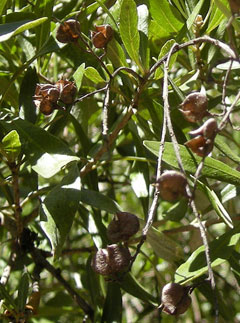 |
|
http://commons.wikimedia.org/wiki/File:Bursaria_spinosa_flowers.jpg |
 |
| http://commons.wikimedia.org/wiki/File:Bursaria_spinosa_opened_fruit.jpg |
Translate this page:
Summary
Physical Characteristics

 Bursaria spinosa is an evergreen Shrub growing to 4.5 m (14ft 9in).
Bursaria spinosa is an evergreen Shrub growing to 4.5 m (14ft 9in).
See above for USDA hardiness. It is hardy to UK zone 8. It is in leaf all year, in flower in August. The species is hermaphrodite (has both male and female organs) and is pollinated by Bees.
It is noted for attracting wildlife.
Suitable for: medium (loamy) soils and prefers well-drained soil. Suitable pH: mildly acid, neutral and basic (mildly alkaline) soils. It cannot grow in the shade. It prefers moist soil.
UK Hardiness Map
US Hardiness Map
Synonyms
Plant Habitats
Woodland Garden Sunny Edge; Hedge; South Wall. By. West Wall. By.
Edible Uses
References More on Edible Uses
Medicinal Uses
Plants For A Future can not take any responsibility for any adverse effects from the use of plants. Always seek advice from a professional before using a plant medicinally.
Skin
Skin. The leaves contain the coumarin 'aesculin' - this is used in the treatment of lupus by irradiation and as a screen from ultra-violet light in suntan lotions[152].
References More on Medicinal Uses
The Bookshop: Edible Plant Books
Our Latest books on Perennial Plants For Food Forests and Permaculture Gardens in paperback or digital formats.

Edible Tropical Plants
Food Forest Plants for Hotter Conditions: 250+ Plants For Tropical Food Forests & Permaculture Gardens.
More

Edible Temperate Plants
Plants for Your Food Forest: 500 Plants for Temperate Food Forests & Permaculture Gardens.
More

More Books
PFAF have eight books available in paperback and digital formats. Browse the shop for more information.
Shop Now
Other Uses
Hedge Hedge Weather protection Wood
Leaves contain the coumarin 'aesculin' which is used in the treatment of lupus by irradiation and as an ultraviolet radiation screen in suntan lotions[152]. Plants can be grown as a hedge in mild climates[167]. Wood - tough, hard, close grained, easily worked. Used for tool handles, cabinet making etc[154].
Special Uses
Attracts Wildlife Hedge Hedge Scented Plants
References More on Other Uses
Cultivation details
Requires a well-drained moisture retentive soil in full sun[200]. This species only succeeds outdoors in Britain in the mildest areas of the country[11, 182]. Plants are hardy to at least -7°c in Australian gardens[157], though this cannot be translated directly to British gardens due to our cooler summers and longer, colder and wetter winters. They require a warm south or south-west facing wall in Britain, succeeding in areas where frosts are light and short lived[200]. A good bee plant[167], the flowers are sweetly fragrant[219, 245]. Very ornamental[1].
References Carbon Farming Information and Carbon Sequestration Information
Temperature Converter
Type a value in the Celsius field to convert the value to Fahrenheit:
Fahrenheit:
The PFAF Bookshop
Plants For A Future have a number of books available in paperback and digital form. Book titles include Edible Plants, Edible Perennials, Edible Trees,Edible Shrubs, Woodland Gardening, and Temperate Food Forest Plants. Our new book is Food Forest Plants For Hotter Conditions (Tropical and Sub-Tropical).
Shop Now
Plant Propagation
Seed - sow spring in a greenhouse. It does not require pre-treatment. When large enough to handle, prick the plants out into individual pots. Grow on the young plants for at least the first winter in a greenhouse and plant out in late spring or early summer. Consider giving the plants some protection from winter cold for at least their first winter outdoors. Cuttings of half-ripe wood, July/August in a frame[219]. They require a little bottom heat if they are to root well[245].
Other Names
If available other names are mentioned here
Christmas Bush, Sweet Bursaria
Native Range
AUSTRALASIA: Australia (Tasmania, New South Wales, Queensland, South Australia, Victoria)
Weed Potential
Right plant wrong place. We are currently updating this section.
Please note that a plant may be invasive in one area but may not in your area so it's worth checking.
Conservation Status
IUCN Red List of Threatened Plants Status :

Growth: S = slow M = medium F = fast. Soil: L = light (sandy) M = medium H = heavy (clay). pH: A = acid N = neutral B = basic (alkaline). Shade: F = full shade S = semi-shade N = no shade. Moisture: D = dry M = Moist We = wet Wa = water.
Now available:
Food Forest Plants for Mediterranean Conditions
350+ Perennial Plants For Mediterranean and Drier Food Forests and Permaculture Gardens.
[Paperback and eBook]
This is the third in Plants For A Future's series of plant guides for food forests tailored to
specific climate zones. Following volumes on temperate and tropical ecosystems, this book focuses
on species suited to Mediterranean conditions—regions with hot, dry summers and cool, wet winters,
often facing the added challenge of climate change.
Read More
Expert comment
Author
Cav.
Botanical References
11154200
Links / References
For a list of references used on this page please go here
Readers comment